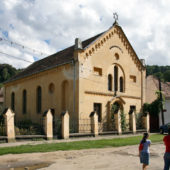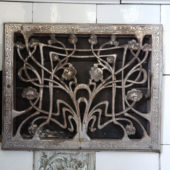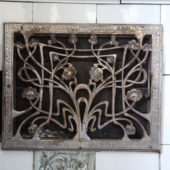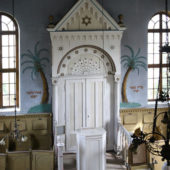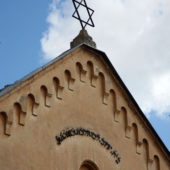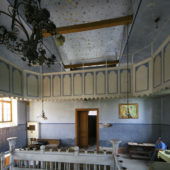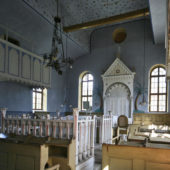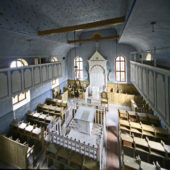Sighisoara’s unusually decorated synagogue features paintings of palm trees and ceiling painted to resemble a starry night.
The Synagogue of Sighisoara is an unusual synagogue in a very unusual town. It has served the Jewish community for over a century, but now, the Jewish community in Sighisoara no longer exists.
The picturesque town of Sighisoara is the birthplace of Vlad Tepes (otherwise known as Dracula) and has become a favorite tourist destination and haunt of Dracula fans. 12th century Saxon Transylvanians founded Sighiosoara, which is one of Europe’s loveliest and best-preserved medieval towns. The Jewish community in Sighisoara was founded in the 1860s and established a Synagogue and yeshiva with approximately 35 students. The Synagogue was built in 1903, at which time the community numbered over 100 members. By 1930 the community had increased to 173 (1% of the town’s total population). On November 27, 1940, a law was passed in which Jews were forced to forfeit their property. The Jewish community was proud of the fact that even though the war was going on in 1942, they were able to open a school for children, and they were instructed in Yiddish. During this time, the community provided aid to approximately 2,000 refugees. By 1956, the community had risen to 217 members. However, after this time, the community dwindled as members emigrated and by 1966, there were only 35 people; by 1977, there were only ten members; in 1992, only two; in 2007 only one; and today there are none.
The Synagogue in Sighisoara is unusually decorated inside. It was built in 1903 and it’s façade looks like an attractive, common, urban structure with a steep-sloped gable roof with pointed pediments. The edifice is plainly plastered and painted a cream color. It features tall, paned, arched and round windows and is decorated with moldings, which enhance the cornices, gables and main entrance. Inside, the prayer room is light blue, with tall, arched, paned windows lining the walls. The ceiling is white with stars hand-painted on it. The upstairs balcony (the women’s gallery) lines three walls, and is painted in cream with light blue decorative trim. The pews are also painted cream with light blue decorative trim. At the far end of the sanctuary on the East wall, is the Aron Kodesh carved out of wood and painted white, with a dark blue Star-of-David sitting near the top of it. Palm trees are painted on the wall, on either side of the Aron Kodesh. A round window sits above the ark and arched, paned windows are on either side of it. There is paneling along the back wall of the bimah, painted in cream with light blue decorative trim. There is also a podium in front of the Aron Kodesh, also painted white, with balustrades along the sides from the bimah to the podium and again surrounding the tevah (reader’s desk), which is situated in the middle of the sanctuary. The tevah is also painted white.
The last Jew that lived in Sighisoara was Eliu David Raducanu. He was the custodian of the Synagogue and delighted in giving people tours and telling them about the history of the community. Apparently, the last minyan (religious service requiring at least ten men) took place in 1985. Mr. Raducanu kept the Synagogue in nearly perfect condition, with the exception of one wall, which was prone to dampness. The Federation paid for the upkeep of the Synagogue. Mr. Raducanu sent the Torah scrolls to Bucharest.
The doors of the Synagogue re-opened on August 23, 2007, after having been closed for over 20 years. Sadly, the Synagogue is no longer in use but it is available to be visited. There is no longer a community is Sighisoara to make use of this worthy house, that served the Jewish people for over a century.

